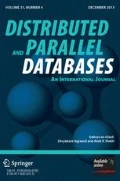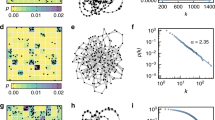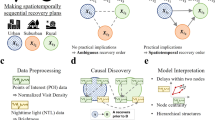Abstract
Many applications require understanding how event occurrences at one geographical region affect or influence event occurrences at another region, e.g. spread of disease and forest fires. Existing works typically impose a grid to partition the spatial space and utilize spatial autocorrelation property to model the spatial dependency among the grid cells. However, they are often highly sensitive to the granularity of the grid size and they do not incorporate the temporal dynamics of the event occurrences among regions. This paper utilizes the notion of a spatial network with temporal dependency to capture the dynamics of event occurrences among regions. This network is modeled as a directed graph where each node is a group of spatially nearby events and each directed edge represents the influence of events from a source node to a destination node. We design an algorithm called LinkNet to generate this network from spatio-temporal event databases. LinkNet utilizes minimum description length based information–theoretic approach to automatically adjust the number of regions and the temporal relationships among regions. Two optimizations are devised to reduce the computational complexity of LinkNet. We also demonstrate how the proposed network can be used for hotspot prediction. Experiment results on both synthetic and real world datasets demonstrate the efficiency of LinkNet and the effectiveness of the network in predicting the next hotspots.



















Similar content being viewed by others
Notes
Note that, the time complexity of \(NodeCost(V,D)\) is \(O(|D|)\) instead of \(O(|V|)\) This is due to fact that region discovery algorithm has \(|D|\) regions at the start of algorithm and progressively number of regions are reduced by one in each iteration.
References
Agarwal, D., McGregor, A., Phillips, J., Venky, S., Zhu, Z.: Spatial scan statistics: approximations and performance study. In: ACM SIGKDD, (2006)
Aggarwal, C.: A framework for change diagnosis of data streams. In: SIGMOD, pp. 575–586, (2003)
Aloise, D., Deshpande, A., Hansen, P., Popat, P.: Np-hardness of euclidean sum-of-squares clustering. Mach. Learn. 75, 245–249 (2009)
Chainey, S., Tompson, L., Uhlig, S.: The utility of hotspot mapping for predicting spatial patterns of crime. Secur. J. 21, 4–28 (2008)
Chang, W., Zeng, D., Chen, H.: A spatio-temporal data analysis approach based on prospective support vector clustering. Decis. Support Syst. 45, 697–713 (2008)
Cho, Y., Galstyan, A., Brantingham, J., Tita, G.: Latent point process models for spatial-temporal networks. In: Bayesian Modeling Applications Workshop (2012)
Dong, W., Zhang, X., Li, L., Sun, C., Shi, L., Wei, S.: Detecting irregularly shaped significant spatial and spatio-temporal clusters. In: SDM (2012)
George, B., Kim, S., Shekhar, S.: Spatio-temporal network databases and routing algorithms: a summary of results. In: SSTD (2007)
Gonzalez, H., Han, J., Li, X., Myslinska, M., Sondag, J.: Adaptive fastest path computation on a road network. In: VLDB (2007)
Gruwald, P., Myung, J., Pitt, M.: Advances in Minimum Description Length. MIT Press, Cambridge (2005)
Huang, Y., Zhang, L., Zhang, P.: A framework for mining sequential patterns from spatio-temporal event data set. TKDE 19, 453–467 (2008)
Lee, J., Han, J., Li, X., Cheng, H.: Mining discriminative patterns for classifying trajectories on road networks. IEEE TKDE 23, 713–726 (2011)
Levine, N.: Crimestat III: a spatial statistics program for the analysis of crime incident locations (2010)
Lu, W., Zheng, Y., Chawla, S., Yuan, J., Xing, X.: Discovering spatio-temporal causal interactions in traffic data streams. In: ACM SIGKDD (2011)
Maciejewski, R., Hafen, R., Rudolph, S., Larew, S., Mitchell, M., Cleveland, W., Ebert, D.: Forecasting hotspots : a predictive analytics approach. IEEE Trans. Vis. Comput. Graph. 17(4), 440–453 (2011)
Monreale, A., Pinelli, F., Trasarti, R., Giannotti, F.: Wherenext: a location predictor on trajectory pattern mining. In: KDD, pp. 637–646 (2009)
Natalia, A., Gennady, A.: Spatial generalization and aggregation of massive movement data. IEEE Trans. Vis. Comput. Graph. 17, 205–219 (2011)
Patel, D., Chang, S., Hsu, W., Lee, M.L.: Incorporating duration information for trajectory classification. In: IEEE ICDE (2012)
Shekhar, S., Schrater, P., Vatsavai, R., Wu, W., Chawla, S.: Spatial contextual classification and prediction models for mining geospatial data. IEEE Trans. Multimed. 4, 174–188 (2002)
Ugur, D., Kashani, F., Shahabi, C., Ranganathan, A.: Online computation of fastest path in time-dependent spatial networks. In: SSTD (2011)
Zeng, D., Chen, H., Chavez, C., Lober, W., Thurmond, M.: Infectious Disease Informatics and Biosurveillance. Springer, New York (2010)
Author information
Authors and Affiliations
Corresponding author
Appendix
Appendix
This appendix provides the mathematical proofs of the theoretical results discussed in Sect. 4.
1.1 Appendix 1: Proof for Theorem 1
Proof
This proved the theorem. \(\square \)
1.2 Appendix 2: Proof for Eq. (1)
Proof
Recall, \(|V'|\) = \(|V|-1\).
The sum of squares of the distances in Eq. (5) can be simplified as follows:
By substituting Eq. (6) into Eq. (5), we have
This proved the equation. \(\square \)
1.3 Appendix 3: Proof for Theorem 3
We have used following lemma in Theorem 3 to show that \(maxNodeGain(R_i,R_j)\) is an upperbound estimation of \(NodeGain(R_i,R)\).
Lemma 1
Let \(N\) be a positive integer and \(x\) is a variable. The function \(f:[1,\infty ] \rightarrow [1,\infty ]\), \(f(x)=(N+x)\mathrm{log}(N+x)-x\mathrm{log}(x)-N\mathrm{log}N\) is monotonic increasing.
Proof
To prove that \(f\) is monotonic increasing, we will show that the first derivative of \(f\) is greater than 0.
Clearly, \(\frac{df(x)}{dx}\) \(>\) 0. This proved the equation. \(\square \)
Now, we prove Theorem 3 that is discussed in Sect. 5.1.2.
Proof
Recall that \(max\_size\) is the maximum size of any region that appears after and including region \(R_j\) on the orderline. This implies \(max\_size\) \(\ge \) \(|R|\). From Lemma 1,
Since \(min\_size \le |R|\) and \(ndist_{ij} \le Dist(R_i,R)\), we have
Therefore,
This proved the theorem. \(\square \)
1.4 Appendix 4: Proof for Eq. (3)
Proof
We can simplify the sum of squares of distances in Eq. (8):
By substituting Eq. (9) into Eq. (8), we have
This proved the equation. \(\square \)
Rights and permissions
About this article
Cite this article
Patel, D., Hsu, W. & Lee, M.L. LinkNet: capturing temporal dependencies among spatial regions. Distrib Parallel Databases 33, 165–200 (2015). https://doi.org/10.1007/s10619-014-7147-9
Published:
Issue Date:
DOI: https://doi.org/10.1007/s10619-014-7147-9




